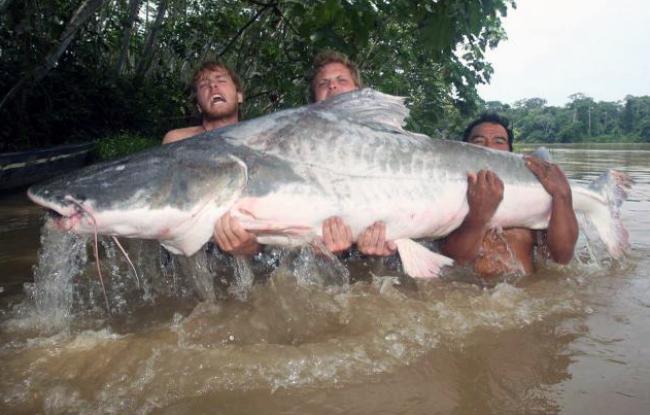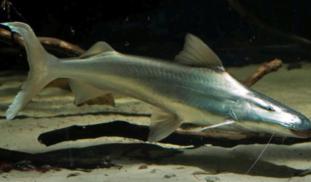How Cool are Goliath Catfish? Really, Really Cool!

Can a catfish really be cool? I mean, it’s a catfish right; smooth and slimy, whiskers and muddy water? Not cool? Think again. Think colorful, gigantic, predatory, and behavior that is truly unique and amazing. These are the goliath catfish of the Amazon basin.
The catfish known as “goliath” catfish are not just one species. There are several common species and many more that are more rare that we know quite literally zilch about. They come in all kinds of colors, from the metallic silver-gold of the most populous species (the dourada), to tiger stripes, spots, and dramatic red. Some have long whiskers, called barbels, and others are short. Some of these fish are fat, muscular, bruisers…capable of ascending rough rapids to spawn. Others are long and delicate, with extended faces that make them look almost comical.

Some are ambush predators that spend most of their time waiting, but many are active piscivores (fish eaters) that use their barbels and other sensing organs to sense the presence of prey in the muddy water and attack. Because they tend to hang out in muddy rivers they tend to have small, beady, less developed eyes.
Many are also thought to be scavengers, happy to feed on the misfortune of other fish and animals that end up in the water. It is this scavenging behavior that, scientists believe, is the source of rumors that the piraíba (which can reach 12 feet long) includes the occasional human in its diet. Yes, human remains have reportedly been found inside large piraíba…but they are luckily (I’m not sure lucky is the right word here) people who died for other reasons before being devoured.

Still these catfish are apex predators. What lions are to the Serengeti, goliath catfish are to the main channels of the Amazon river basin. Alongside the pink Amazon river dolphin, and the occasional bull shark that wanders upriver, catfish are the apex predator in the main channels throughout the Amazon river.
As if this wasn’t cool enough we haven’t even made it to the most incredible part of their ecology! Not every species is migratory, but at least two species make stunning migrations that cross the continent from the Atlantic Ocean to the Andes Mountains. This is an incredibly long distance, but it’s hard to get a handle on. Let’s put it in perspective…

The dourada make the longest known freshwater migration, 5,500km (3,400 miles). That’s just shy of the distance that swimmer Ben Lecompte swam to cross the Atlantic Ocean in 1998. His first words after coming ashore were, “never again,” just to give you some idea of how long a distance that is. He then dropped to his knee and proposed to his wife…not exactly the same as a spawning migration, but she had rebuffed him both before and during the trip so I guess that swim was worth it!

In comparison to other animal migrations the dourada have a longer migration than the record for a terrestrial mammal, the caribou (4,800 km). They also outpace the longest salmon run (3,000 km), and travel further than the iconic monarch butterfly that migrates 7,000km but has to split that into 3-4 generations. For more context, 5,500km is the distance from the geographic center of China to the geographic center of Iraq; as well as the distance from New York City to the equator by sea; or a road trip from Seattle to Chicago to Miami. This is a long migration by any measure, though admittedly it doesn’t come close to the arctic tern…but who wants to beat a 70,900 mile migration between Antarctica and Iceland.

Despite all the amazing reasons to love the goliath catfish there hasn’t been much love going their way in the form of research. We’ve known for a long time that the populations are overfished and populations are declining along with the size of individuals (speaking of love, Europe and Asia love to eat them. Millions of pounds of these fish are caught every year and mostly shipped overseas). Most of what we know comes from fisheries records. A great book titled “The Catfish Connection” synthesized all of the fisheries data and made the scientific case for this long distance migration and it’s ecological importance. But, the migration is too long, the rivers too large and muddy, and the resources devoted to studying them too small, to have really understood their migration using normal fisheries ecology tools.

That is changing with the realization that the migratory goliath catfish may be facing the same threats that caused the crash of Atlantic and Pacific salmon…dams and overfishing. At the same time technology innovations have allowed us to study this migration in incredible new ways.
My collaborators and myself were the first to show that it was possible to track the migration of these fish using the isotopic signatures in their ear bones, showing that their migration was more complex than we thought. Since then other researchers have followed our lead, showing more evidence that goliath catfish home to their natal rivers somewhat like salmon. Interest in understanding this incredible migration is growing as more dams are completed in the Madeira river headwaters and other places in the Amazon basin.

We are raising money to continue and expand or study of these amazing fish because they are so freaking cool, and now is the time to learn about them…while populations are still high and the risks from dams and overfishing can be managed. I’m incredibly excited about this research. The tools we are using are really cool, and I think we will be able to learn much more about these amazing fish. If you would like to get involved I’d like your help.

To get involved go to our Experiment site and donate (even just a dollar is worth it and appreciated). For your trouble you’ll get to follow along as we do this work. I’ll be posting updates as we do the work, letting you know what it’s like to do this work and you’ll see the results as soon as we have them.
If you can donate before May 3
I’m looking forward to hearing from you and starting a discussion as we start this work on the incredible goliath catfish of the Amazon!









2 comments